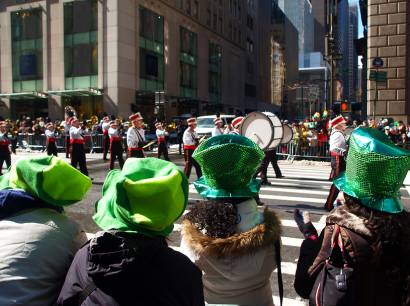This Week's Story
subscribe to podcast [click here] or play audio below
I knew I should wear green on St. Patrick's Day or I would get pinched. But, how come?

This Week’s Story relives American history and the Bible through brief inspiring stories presented on mp3 audio recordings and text for reading.
St. Patrick with a Capital S,
part one
Since I was a little girl I knew I should wear green on St. Patrick’s Day. If I didn’t, someone would pinch me. On that day I saw walls decorated with mischievous little green men and green shamrocks. Each shamrock was a green clover sprig with three round curvy leaves. People smiled when they thought of St. Patrick’s Day. The day came from Ireland.
Today I was in my classroom looking at my seventh graders. We should know something about St. Patrick.
I got the P volume from the World Book Encyclopedia in the classroom and began reading. My brain started twitching with excitement! The facts about him were few, but amazing! St. Patrick started more than 300 churches and baptized more than 100,000 people in Ireland! Wow! I reread the article and checked other encyclopedias. Most had the same astonishing figures. How come I had never heard them?
I learned that there were many legends and a few historical facts about St. Patrick. There was the legend about St. Patrick charming the
snakes of Ireland into a sea where they drowned. I know legends are supposed to have some shreds of truth, but Ireland wasn’t known to have any snakes. I wanted historical facts, not legends. Who was Patrick the man, not Patrick the snake charmer?
Since the day I met St. Patrick, I have come to know him better. I know something remarkable happened when he was in Ireland. That was over one thousand five hundred years ago. Much has happened in Ireland since then.
Many Irish people came to the United States in the 1840’s during a horrendous potato famine and starvation. About one million people died. But, there was a lingering influence of something connected with St. Patrick that left people in many countries knowing the name St. Patrick.
I learned in textbooks that once Ireland had tribes that specialized in killing each other. Then came a great change. As history books would state, “Christianity brought unity among warring tribes.” The extraordinary pivotal person was St. Patrick. Though he never formally was recognized as a saint by the Roman Catholic Church, the Irish called him Saint Patrick with a capital S.
He wrote two pieces of writing that have survived to our time. They are his mini autobiography The Confession and the Letter to Coroticus. You can buy them in paperback edition. The writing is not like we talk or write, but you sense that the writer is not exaggerating or talking about what a great person he was. You learn that God was the center of whom he became.
He tells you, “I was not born Irish. I lived with my parents in Britain. My father was a respected town council member and church deacon. My parents were Christians and part of the Roman Catholic Church. I cared nothing about the church or God. I thought the priests were foolish.
“When I was almost sixteen, Irish pirates captured me, took me to Ireland, and sold me! I had been a free teenager who liked having a good time with buddies. I became a slave! My owner was Milchu, an Irish chieftain. He forced me to care for his sheep.
For six years I survived in forests and mountainsides. I was usually with the sheep I tended. I changed. ‘The Lord opened my senses to my unbelief...it was he who strengthened me, consoling me just as a father comforts his son.’”
This is Barbara Steiner. In Part Two let us hear more about St. Patrick.
You are invited to visit thisweeksstory.com.
<< previous story] [next story >>
We invite your comments! [click here to comment]
This Week's Story is a non-profit supported by listeners. [click here to make a donation]
